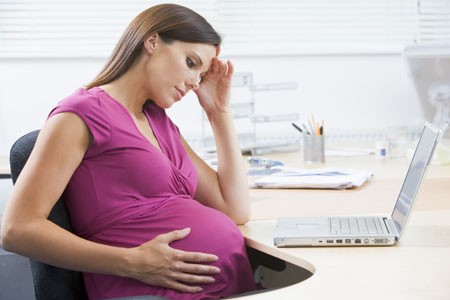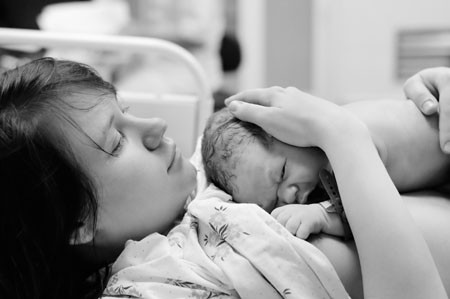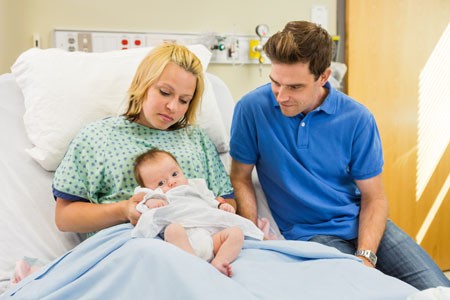Safety of Atypical Antipsychotics in Pregnancy
A 2017 article in the Journal of Clinical Psychiatry systematically reviewed data on the risks related to schizophrenia, bipolar disorder, and treatment with atypical antipsychotic medication during pregnancy. The article by researcher Sarah Tosato and colleagues suggests that a mother’s illness may be more harmful to a fetus than treatment for that illness is.
The review analyzed 49 articles about illness-related and atypical antipsychotic–related risks in bipolar disorder and schizophrenia. Tosato and colleagues found that abrupt discontinuation of treatment led to a high risk of relapse in pregnant women with bipolar disorder or schizophrenia.
Schizophrenia was linked to a slight increase in obstetric complications for mothers, while both bipolar disorder and schizophrenia were linked to a slight increase in complications for newborns. Mothers ill with schizophrenia had the highest risk for serious complications, including stillbirth, neonatal or infant death, and intellectual disability in the child.
The researchers reported that untreated bipolar disorder and schizophrenia are risk factors for birth defects, but use of atypical antipsychotics is not. Children’s neurodevelopment also does not seem to be affected by mothers’ use of atypical antipsychotics during pregnancy.
The authors suggest that, given parents agree and understand any risks involved, the least harmful choice of action is to maintain treatment of women with bipolar disorder and schizophrenia during pregnancy at the safest minimum dosage to keep their illness at bay.
In Small Open Study, Dietary Supplement Improves Post Partum Blues
Post-partum depression affects 13% of new mothers, but little is known about how to prevent it. Doctors are researching ways of reducing post-partum blues, which can occur 4–6 days after delivery, when levels of the enzyme monoamine oxidase-A are high. At a 2015 scientific meeting, researchers led by Yekta Dowlati of the Centre for Addiction and Mental Health at the University of Toronto reported that a nutritional supplement designed to counteract the high levels of monoamine oxidase-A improved depression among 17 healthy women who had recently given birth, compared to 16 new mothers who did not receive the supplement. The supplement contained 2g of tryptophan and 10g of tyrosine, both amino acids found in protein-rich foods, plus blueberry juice and a blueberry extract.
Treating Women During Pregnancy and Breastfeeding
A Danish working group has released guidelines for prescribing psychotropic drugs to women who are pregnant or breastfeeding. After a comprehensive review of the literature, researchers from several different Danish medical societies reported that sertraline and citalopram are the first choice among selective serotonin reuptake inhibitors (SSRIs) for depression in women who are pregnant or breastfeeding. The working group suggested that women with bipolar disorder who need a mood stabilizer because of frequent relapses could be prescribed lithium, though lithium use is associated with a small risk of cardiac abnormalities in the child. Lamotrigine may also be used, and has not been associated with any congenital abnormalities.
Valproate and carbamazepine are not recommended for use during pregnancy and breastfeeding. Use of valproate among women of child-bearing age should particularly be avoided due to several risks for the potential child. These include spina bifida and other serious congenital problems, but also severe developmental delay and loss of about 9 IQ points. Other possible treatments for bipolar disorder and schizophrenia in pregnant and breastfeeding women include olanzapine, risperidone, quetiapine, and clozapine. The data about the safety of these medications are not extensive.
The working group included members of the Danish Psychiatric Society, the Danish Society of Obstetrics and Gynecology, the Danish Paediatric Society, and the Danish Society of Clinical Pharmacology. The recommendations may be found in an article by E.R. Larsen and colleagues in a 2015 supplement to the journal Acta Psychiatrica Scandinavica.
Maternal Infection During Pregnancy May Increase Risk of Schizophrenia in Offspring
 There is mounting evidence from animal studies and epidemiological research that an infection during pregnancy may increase the risk of schizophrenia in the offspring. A recent study by Alan Brown and colleagues presented at the 2015 meeting of the Society of Biological Psychiatry used a large dataset from the Finnish Prenatal Study of Schizophrenia to compare medical data from the mothers of 777 people with schizophrenia (630 with schizophrenia and 147 with schizoaffective disorder) to data from the mothers of 777 healthy people.
There is mounting evidence from animal studies and epidemiological research that an infection during pregnancy may increase the risk of schizophrenia in the offspring. A recent study by Alan Brown and colleagues presented at the 2015 meeting of the Society of Biological Psychiatry used a large dataset from the Finnish Prenatal Study of Schizophrenia to compare medical data from the mothers of 777 people with schizophrenia (630 with schizophrenia and 147 with schizoaffective disorder) to data from the mothers of 777 healthy people.
The study’s biobank contained blood samples taken from the mothers in early to mid-pregnancy, which the researchers used to determine the mothers’ levels of C-reactive protein (CRP), an indicator of inflammation. Higher levels of CRP were associated with increased risk of schizophrenia in the offspring. When the researchers analyzed the findings by sex of the offspring, the link between prenatal infection and schizophrenia risk was significant in males, but not females. The effect was also stronger among offspring born after their due date than those born at or before their due date.
Low Oxytocin Linked to Depression in Moms
At a panel at the 2015 meeting of the Society of Biological Psychiatry, researcher Andrea Gonzales described her team’s study of mechanisms related to postpartum depression and the bonding hormone oxytocin. In the study of 26 women at eight months postpartum, the team examined whether there were connections between a mother’s levels of oxytocin at baseline and after interacting with her child, her mood symptoms, and whether she was mistreated in childhood.
Those women who scored low on a history of maltreatment in childhood had bigger increases in oxytocin in their blood and saliva after interacting with their children. Those with high trauma scores but low levels of depression also saw big boosts in oxytocin after seeing their children. Those women who had both a history of trauma in childhood and current depressive symptoms did not get as big a boost of oxytocin after interacting with their children.
Gonzales and colleagues concluded that postpartum depression is linked to dysregulation of oxytocin levels, and that a history of trauma in the mother’s childhood can make this worse.
The researchers hope that these findings may make it easier to identify which women are at risk for postpartum depression, and that they may point to possible treatments in the future.
Postpartum depression is a problem for about 13% of mothers in the year after they give birth, and mother-child bonding may be disturbed if a mother is depressed. One way to foster better bonding between a depressed mother and her newborn is to use video feedback. A mother views video of herself interacting with her child while a trained professional helps her identify opportunities for greater physical contact.
Maternal Warmth Does Not Negate Corporal Punishment
New research shows that expressions of maternal warmth following corporal punishment do not reduce children’s anxiety, and may even increase it.
The study by Jennifer E. Lansford and colleagues was published in the Journal of Clinical Child & Adolescent Psychiatry. The researchers interviewed over a thousand children aged 7–10 and their mothers about what type of physical punishment occurs in their family, and about anxiety and aggression in the children. They followed up again after one and two years. The study took place in eight countries: China, Colombia, Italy, Jordan, Kenya, the Philippines, Thailand, and the United States.
In general, corporal punishment increased anxiety in the children, while maternal warmth decreased it. How warmth and physical punishment interacted depended on the country. Anxiety increased over time in families where the mothers were high on both corporal punishment and warmth. Lansford and colleagues wrote that it might be “simply too confusing and unnerving for a child to be hit hard and loved warmly all in the same home.”
The researchers suggest that parents use nonphysical ways to promote desirable behavior in their children, including putting younger children in time-out and requiring teenagers to participate in activities that help others.
Mother’s Treatment for Depression Can Affect Children’s Symptoms
Studies have found that when a depressed mother’s symptoms remit, her children are less likely to show psychiatric symptoms. A new study by Myrna M. Weissman and colleagues in the American Journal of Psychiatry randomized 76 mothers to treatment with escitalopram, bupropion, or a combination of the two, and assessed the impact of the mothers’ treatment on their 135 children (aged 7–17).
There were no significant differences in the mothers’ symptoms or remission, but children’s depressive symptoms and functioning improved more if their mothers received (only) escitalopram. Only in that group was a mother’s improvement associated with her children’s improvement.
Mothers in the escitalopram group reported greater improvement in their ability to listen and talk to their children compared to the mothers in other groups, and the children of the mothers in the escitalopram group reported that their mothers were more caring.
Children of mothers with low negative affect improved significantly, while children of mothers with high negative affect only improved if their mothers were in the escitalopram group.
The authors suggest that for a mother’s improvement to help her children’s symptoms, her anxious distress and irritability must be reduced, and these may be better targeted with escitalopram than bupropion.
Early Life Stressors Lead to Lifetime Increase in Inflammation in Mice
Stressors in early life can contribute to the risk of developing mood disorders. Given that many treatments for mood disorders work by blocking the serotonin 5-HT transporter, Nicole Baganz and colleagues designed a study to see whether an early life stressor, in this case maternal separation, would affect immune processes that in turn affect serotonin signaling.
In this study as in many before it, mice that were removed from their mothers exhibited behaviors that resembled human anxiety and depression. They were also found to have elevated messenger RNA for several inflammatory cytokines (including IL-1beta and IL-6) in their brain and blood. Mice that had a gene for the interleukin-1 receptor (IL-1R) removed exhibited neither the depressive behavioral effects nor the changes in cytokine levels following maternal separation, showing that the IL-1R gene plays a necessary role in the signaling process that leads to this type of depression. Levels of the stress hormone corticosterone in the blood did not differ in the mice with and without the IL-1R gene.
The researchers concluded that early life stressors can cause lifelong changes in inflammatory cytokine levels in mice.
Young Rats That Witness Maternal Abuse Show Depression-Like Behavior in Adulthood
Rodents that are subjected to social defeat (being overpowered by a bigger, more aggressive animal) develop a syndrome that resembles human depression—they avoid social interaction, lose interest in sucrose, and do less exploring of new places or other animals. A recent finding showed that even witnessing the social defeat of a peer was enough to bring about the depressive behaviors. The same researchers, led by Samina Salim, recently found that young rats (aged 21–27 days) that witnessed their mother go through the trauma of social defeat showed depression-like behavior themselves as adults (at age 60 days).
The rats saw their mothers defeated by the larger rat every day for seven days. As adults, those who witnessed this abuse exhibited depression-like behavior compared to rats of the same age and gender that had not witnessed abuse. The depressive rats gave up more quickly on a test of forced swimming. Male rats showed great depression-like behavior than female rats.
It has been estimated by the American Psychological Association that 15.5 million children in the US witness physical or emotional abuse of a parent (usually their mother). Children who witness domestic violence often show symptoms of post-traumatic stress disorder (PTSD). This rodent research may lead to a better understanding of the consequences of witnessing trauma in childhood, and potential treatments that could help.
Editor’s Note: These data show that rats have something like empathy, and that the psychological aspects of stress (including verbal abuse in humans and witnessing another’s abuse in rodents) may have profound and lasting consequences on behavior.
Maternal Childhood Adversity Associated with Low Infant Birth Weight
In a study of the effect on infant health of a mother’s experience of adversity in childhood by researcher Deborah Kim and colleagues, both adversity in childhood (such as physical abuse or the loss of a parent) and stress during pregnancy were associated with low infant birth weight and lower gestational age at birth.
Among 146 women enrolled in the study, 58.2% percent scored a 0 on the Adverse Childhood Experience Questionnaire (ACE), 24% scored a 1, and 17.8% scored a 2. Those who scored higher on the ACE also scored higher on a scale measuring perceived stress. A score of 2 or higher on the ACE was associated with lower gestational age at birth, indicating infants born prematurely. Greater stress during pregnancy was associated with lower gestational age at birth and lower infant birth weight. When potential confounding demographic factors were removed from the analyses, ACE scores of 2 or higher were still associated with lower infant birth weight, while perceived stress was no longer associated with either low birth weight or gestational age.
Childhood adversity is associated with increases in inflammation and multiple adverse medical consequences in adults. The researchers called childhood adversity a “significant predictor of poor delivery outcomes” for women.
Editor’s Note: This research shows that a mother’s health and earlier life stressors could have an adverse effect on her child.
Childhood adversity leaves behind a residue of neuroendocrine and neuroclinical alterations that can persist into adulthood. Many are mediated by epigenetic changes, consisting of small chemical marks that attach to DNA and the histones around which it is wrapped.
In addition to these neurobiological alterations mediated by epigenetic effects, there is new evidence that some epigenetic marks can be passed on to the next generation via a mother’s egg or a father’s sperm. Thus, either directly or indirectly, parents’ adverse life experiences can influence the health of their offspring.










